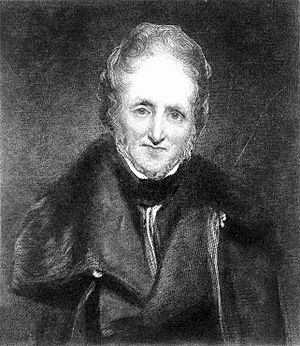George Field (chemist) facts for kids
George Field (born around 1777, died 1854) was a clever English chemist. He was born in a town called Berkhamsted in Hertfordshire. George went to St. Peter's school there. When he was about 18, he moved to London to start his career. He saw a great opportunity in using chemistry to make better pigments (colors) and dyes.
At the time, a war in Europe made it hard to get a special red dye called madder from Holland. This problem made George think about how madder was grown. He came up with a good plan and went to talk to Sir Joseph Banks, a famous scientist, for advice. Sir Joseph had tried to grow madder in England before but failed, so he thought it couldn't be done.
George Field's Cool Inventions
Even though Sir Joseph Banks was doubtful, George Field decided to try growing madder in his own garden. He succeeded! From the roots he grew, he made beautiful coloring materials. But he needed a way to make the liquid colors super smooth.
He invented something amazing called a 'physeter' or percolator. This machine used atmospheric pressure to filter liquids perfectly. He showed his percolator, along with an improved drying oven and press, to the Society of Arts. In 1816, they gave him a gold medal for his "apparatus for preparing coloured lakes" (which are special art pigments). His inventions were even described in the Society's official papers! Interestingly, other people later patented his percolator for clearing sugar, even though George invented it first.
George kept using science to help artists. His skill in making delicate colors was unmatched. He also invented a 'metrochrome' and special conical lenses. These lenses could create a continuous rainbow with cool refraction effects, showing how light bends.
His Life and Legacy
George Field passed away on September 28, 1854, at the age of 77. He was living in Isleworth, Middlesex, at the time. He left some interesting things to different places. He gave six architectural drawings to the Royal Institute of British Architects. To the Hanwell Lunatic Asylum, he gave a painting called 'The Maniac'. He also donated a portrait of Dr. William Harvey to the library of London University.
Books George Field Wrote
George Field was also a writer. His most famous book was Chromatography; or, a Treatise on Colours and Pigments, and of their Powers in Painting. This book was published in London in 1835 and taught artists all about colors. It was so popular that it was updated and re-released several times.
He also wrote Rudiments of the Painter's Art; or, a Grammar of Colouring in 1850. This book was also updated by others later, adding sections on different painting styles like sepia, water-colors, and oils. George also wrote several other books about philosophy and science, sharing his ideas about the world.


